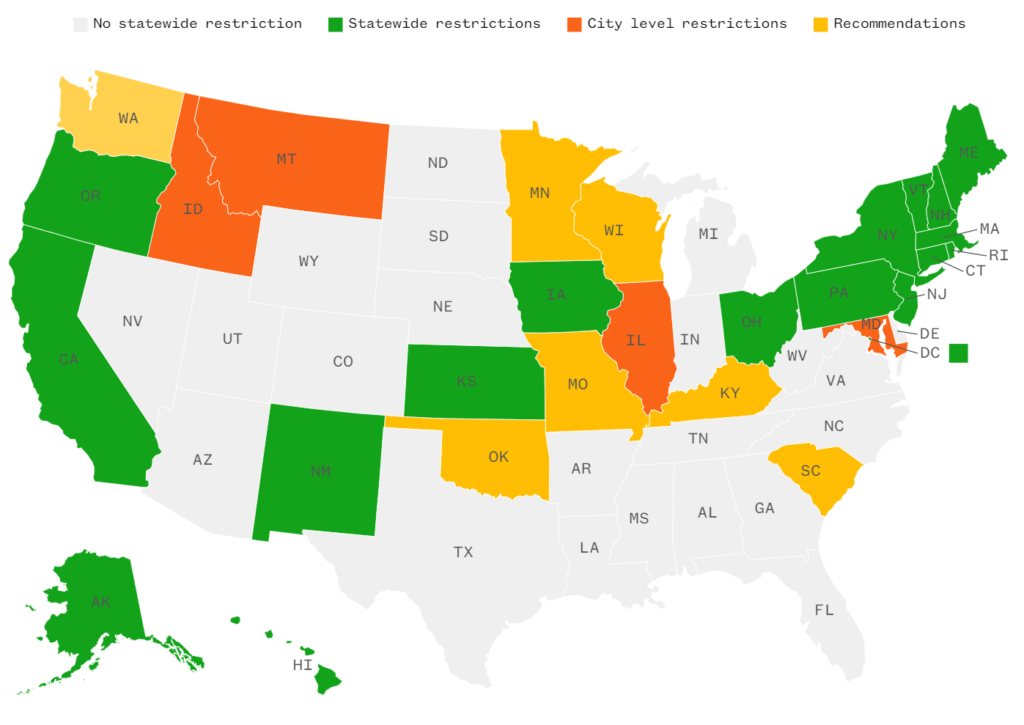Coronavirus Travel Restrictions by State
- Published -
As we look forward to traveling in our RVs in 2021, it’s important to be on the lookout of any travel restrictions which can affect our movement. NBC News has compiled the below list of states that have a statewide restrictions (green), city level restrictions (orange), recommended restrictions (yellow) and no restrictions (gray).

| States | Restrictions |
|---|---|
| Alaska | Travelers into Alaska must submit a form through the state’s online portal and are now required to social distance for 5 days, even with negative test result. Travelers without a test before arrival can get tested at the airport and quarantine until a negative result. If staying for longer than 7 days, a second test should be taken 5-14 days after arrival. Residents leaving and returning to Alaska within a 72 hour window do not need to test or quarantine on return. |
| California | All people arriving in California from other states or countries, including returning California residents, should self-quarantine for 14 days after arrival and limit interactions to their immediate household. Californians are encouraged to stay at home and avoid non-sessential travel to other states or countries. Travelers coming into LA must sign waiver in compliance with travel advisory. Santa Clara County requires a 14 day quarantine for travelers in and out of the county. |
| Connecticut | Must quarantine for 14 days and complete a Travel Health Form if staying in the state for more than 24 hours and coming from one of the states and territories on travel restriction. Those states and territories are Alabama, Alaska, Arizona, Arkansas, California, Colorado, Delaware, Florida, Georgia, Guam, Idaho, Illinois, Indiana, Iowa, Kansas, Kentucky, Louisiana, Maine, Maryland, Massachusetts, Michigan, Minnesota, Mississippi, Missouri, Montana, Nebraska, Nevada, New Hampshire, New Mexico, North Carolina, North Dakota, Ohio, Oklahoma, Oregon, Puerto Rico, South Carolina, South Dakota, Tennessee, Texas, Utah, Vermont, Virgin Islands, Virginia, Washington, West Virginia, Wisconsin, and Wyoming. May also show proof of a negative test within 72 hours prior to arriving instead of quarantining. |
| District of Columbia | Must be tested within 72 hours of traveling to DC. Alaska, Arizona, Arkansas, Alabama, California, Colorado, Connecticut, Delaware, Florida, Georgia, Idaho, Illinois, Indiana, Iowa, Kansas, Kentucky, Louisiana, Massachusetts, Michigan, Minnesota , Mississippi, Missouri, Montana, Nebraska, Nevada, New Jersey, New Mexico, North Carolina, North Dakota, Ohio, Oklahoma, Oregon, Pennsylvania, Rhode Island, South Carolina, South Dakota, Tennessee, Texas, Utah, West Virginia, Wisconsin, and Wyoming. (list updated Nov 5th) |
| Guam | All visitors arriving in Guam must quarantine for 14 days in a government quarantine facility |
| Hawaii | All visitors 5 and older must produce a negative result 72 hours prior to arrival. If negative test cannot be produced before arrival, travelers must quarantine for 10 days. Starting December 2nd, travelers to Kauai County do not have to produce negative test result and can quarantine for 14 days instead. |
| Idaho | No statewide restrictions. Travelers to Boise and other cities in Ada County are encouraged to quarantine for 14 days. |
| Illinois | People entering/returning to Chicago from states other than Vermont and Maine must either quarantine for 14 days or produce a negative test result 72 hours before arrival. |
| Iowa | Travelers to Iowa two or older are required to wear a mask when in indoor public spaces, in state government buildings or in circumstances when 6 foot distance is not possible. |
| Kansas | Visitors for whom any of the following conditions apply must quarantine for 14 days: travel to or from attended gatherings of 500 or more people without social distancing or masks; traveled to or from South Dakota on or after November 4th; traveled to or from the countries of Belgium and Czechia; Attended/traveled to mass gathering events out-of-state of 500 people or greater where individuals do not socially distance (6 feet) and wear masks; Been on a cruise ship or river cruise on or after March 15. been on a cruise ship during or after March; notified by public health officials of close contact with a confirmed case. |
| Kentucky | Those coming from states with at least 15 percent infection rate are asked to quarantine for 14 days. States and territories with at least a 15 percent infection rate are Wyoming, South Dakota, Iowa, Idaho, Kansas, Pennsylvania, New Mexico, Missouri, Alabama, Utah, Montana, Arizona, Mississippi, Oregon, and Ohio. |
| Maine | Residents of New Hampshire and Vermont are allowed to enter without restriction. Everyone else must quarantine for 14 days or sign a form saying they received a negative test within 72 hours |
| Maryland | No statewide restrictions; travelers are asked to contact businesses before visiting |
| Massachusetts | All travelers except those from low risk states, must fill out health form and quarantine for 14 days or provide negative test within 72 hours. Low risk states are Hawaii and Maine. Low risks states meet the following two criteria: average daily cases per 100K below 10 and positive test rate below 5 percent, both measured as a 7-day rolling average. |
| Minnesota | No statewide restrictions but out-of-state travel is highly discouraged. Persons arriving in Minnesota from other states or countries, including returning Minnesota residents, are strongly encouraged to practice self-quarantine for 10 days after arrival by limiting their interactions to their immediate household. |
| Missouri | No statewide restrictions; residents are asked to minimize travel outside of Missouri. If residents travel, they are asked to wear masks and self-isolate upon return |
| Montana | No statewide restrictions; however restrictions may vary on the state’s seven Indian reservations; Montana National Guard are continuing to conduct screenings for related symptoms in airports and train depots |
| New Hampshire | Those not from Maine, Vermont, Massachusetts, Connecticut, and Rhode Island are asked to quarantine for 14 days. |
| New Jersey | Must quarantine for 14 days and complete a Travel Health Form if staying in the state for more than 24 hours and coming from any U.S. state or territory. Non-essential travel is discouraged. |
| New Mexico | Must quarantine for 14 days if traveling from following any state except for Hawaii |
| New York | Travelers from any state that doesn’t border New York must quarantine for 14 days. Can test out of quarantine if negative result is obtained within 3 days of arrival to New York, must quarantine for three days and can end quarantine if negative result is produced. |
| Northern Mariana Islands | All travelers will complete a health form and are required to quarantine for 14 days |
| Ohio | Those coming from high risk areas are asked to voluntarily quarantine for 14 days. High risk is defined by states reporting positive testing rates of 15% or higher based on a 7 day average. Those states currently are South Dakota, Idaho, Iowa, Kansas, Alabama, Montana, Utah, Pennsylvania, Mississippi, Ohio, Missouri, Nevada, Arkansas and Arizona. |
| Oklahoma | No statewide restrictions but visitors should wear face coverings in all public spaces and limit indoors gatherings for 10-14 days |
| Oregon | All people arriving in Oregon from other states or countries, including returning Oregonians, should self-quarantine for 14 days after arrival and limit interactions to their immediate household. Oregonians are encouraged to stay at home and avoid non-sessential travel to other states or countries. |
| Pennsylvania | Requires travelers over age 11 to get tested 72 hours before arrival or quarantine for 14 days. |
| Puerto Rico | Travelers must submit an online declaration form and show proof of a negative molecular COVID-19 test result taken within 72 hours before arriving. |
| Rhode Island | Those traveling internationally or from states where positivity tests are higher 5 percent are required to self-quarantine for two weeks or provide negative test within 72 hours of arrival. Those states are Alabama, Alaska, Arizona, Arkansas, Colorado, Delaware, Florida, Georgia, Idaho, Illinois, Indiana, Iowa, Kansas, Kentucky, Michigan, Minnesota, Mississippi, Missouri, Montana, Nebraska, Nevada, New Mexico, North Carolina, North Dakota, Oklahoma, Ohio, Oregon, Pennsylvania, Puerto Rico, South Carolina, South Dakota, Tennessee, Texas, Utah, Virginia, Wisconsin, and Wyoming. |
| South Carolina | Recommends people from widespreading areas to stay home for 14 days. |
| U.S. Virgin Islands | Every traveler is required to submit a COVID-19 test result via online portal 5 days prior to arrival. If they cannot produce a negative test result, they are required to self-quarantine for 14 days or until they produce negative result |
| Vermont | Travelers from out of state must quarantine for 14 days or show a negative PCR test and quarantine for 7 days. Residents are advised againt non-essential travel |
| Washington | All people arriving in Washington from other states or countries, including returning Washingtonians, should self-quarantine for 14 days after arrival and limit interactions to their immediate household. Washingtonians are encouraged to stay at home and avoid non-essential travel to other states or countries. |
| Wisconsin | No restriction, but some cities and counties may requires visitors to stay home for 14 days. |
